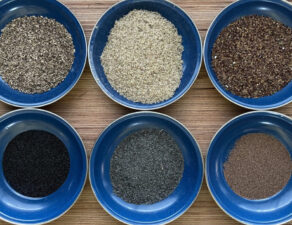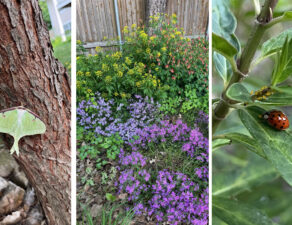
Pictured: Left – Star Tickseed; Top Right: American Plum; Bottom Right: Chokecherry
Here in our Deep Roots community, the choice between exotic ornamentals and native-species plants in our landscapes is a no-brainer – the ecosystem benefits and the support for threatened pollinator species seal the deal for nearly every level of enthusiast. But in our fragmented urban environments, there’s a failsafe way to amplify those benefits even more in spaces where larger-scale restoration or higher-diversity plantings might not be the ideal fit: Selecting keystone species. The suite of native flora that truly hold our ecosystems together outperform many of their counterparts by supporting a disproportionately high number of insect species as both abundant nectar sources for adult invertebrates, and as larval hosts for their offspring.
Take trees, for example: If you are faced with the task of replacing >one tree on your property, and you find yourself saying, “Well, I don’t want an oak – they get way too big,” acknowledge that the Quercus genus supports the highest number of lepidoptera, by far, and then reach for the Prunus. American Plum, and the classic native Chokecherry. Each one can support around 340 unique caterpillar species; will provide perfumed white blooms in spring; and won’t tower much higher than the average suburban roofline – 20-30 feet at maturity. They’re also excellent replacements for invasive honeysuckles and Callery pears in our woodland edges and along our streets.
And it’s not simply the high numbers of different wildlife species that will rely on a plant that define its place in the keystone canon, but also the criticality of their bloom times. The innocuous Asters that have been humbly growing throughout our property all year are now the absolute centerpieces of attention for literally every bug on the block, as sunlight dwindles just as quickly as the selection of flowers to feed on. Every late-migrating Monarch will find those last-dance keystone bloomers to be a lifeline of nectar, fueling their epic journeys southward.
This year, keystones have been a real focal point for Deep Roots KC, as we’ve worked to distill down the wealth of research that supports advocating for certain genera of natives over others. Our Metro straddles the boundary between two distinct eco-regions, and it became imperative to offer a KC-specific ‘hot list’ of ideal keystones to choose for the local landscape, from herbaceous perennials to trees and shrubs. The outcome has been a wonderfully educational webinar, and an invaluable resource guide, published this summer. Be sure to revisit our guest, Sarah Beier’s conversation “A Delicate Weave” from this past winter, and keep the hotlink to our KC Keystones guide handy as you aim to get the most ‘bang for your bug’ in your landscape. We know that even when choosing strictly native plants in our region, if you’re limited in scale and diversity, choosing keystones can amplify your impacts for our wildlife.







